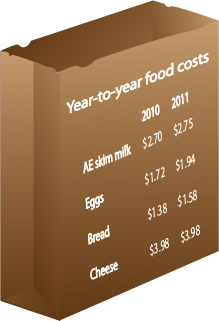Food in high demand in the world, fuel follows close behind

Graphic: Kari Dockum/Iowa State Daily
Year-to-year food costs
February 10, 2011
Higher food prices aren’t just causing turmoil in Egypt — they’re causing a spike in prices in local grocery stores as well.
Demand for scarce resources is the main reason behind higher food prices. The price of wheat, corn, meats and other staple foods are expected to rise and stay at high levels for some time.
Due to inclement weather within the previous year, a number of problems arose:
- Russia — historic droughts devastated wheat crops;
- Australia — record flooding caused losses in sugarcane and wheat;
- Pakistan — monsoons washed away rice, grain and sugarcane.
“Russia is a very large producer of wheat … so to have them say, ‘You know what? We’re not going to have any to export, we’re going to shut our borders down, because we’re not sure we have enough for ourselves’ … it was a dramatic impact on that [wheat] market,” said Chad Hart, assistant professor of economics.
In particular, he said agriculture is a tricky market to predict.
There are many factors that play into what exactly is driving up the cost of basic foods.
“When we look at this issue, there are three main factors that contribute: one, the demand [for resources] overseas is growing; two, supply disruption [due to weather]; and a new player, the biofuels industry,” said Bruce Babcock, professor of economics.
The dilemma at present is not only that a nation is faced with disrupted production, higher demand and newer uses for the crop, but also that there are many nations in the same predicament, making it more difficult for one to help the other, Babcock said.
He added that increases in price of commodities will directly affect the prices of other products such as meats, eggs, dairy and poultry. Small increases in basic foods in the long run will carry over to familiar brands and exaggerate the initial increase.
“When you’re looking at the price of corn in how it relates to the price of a box of Corn Flakes at the grocery store, it only contributes a small amount of that percentage,” Hart said. “So a relatively small price pressure from ag commodities ends up getting multiplied as it goes through each of those middle men [packaging, advertising, shipping] to reach the food shelves that we see at the grocery store.”
The developed world is at an advantage regarding increases in price.
“The average [American] consumer spends less than 10 percent of their income to purchase food … or as we look at some places in Africa, it may be [that] 50, 60, 70 percent of their income is devoted just to purchase food,” Hart said.
The United States Department of Agriculture publishes projections for what will likely unfold in the years to come regarding agricultural commodities, trade, farm income and food prices. The predictions for this decade are deterring, but promising in some aspects.
“Although corn prices are lower than their high 2007-2008 and 2008-2009 levels, they are projected to remain historically high due to continued demand for corn to produce ethanol as well as growth in feed use and exports,” according to the USDA website.
It is safe to assume that along with the increase in price for corn, many other commodities will follow the same trend. The current economical woes are subsiding in moderation.
Rising prices in commodities will help build the economy, to an extent, USDA outlooks and agricultural economists said. In particular, Iowa will see a boost in its economy as a result of higher demand for one of its number one resources: corn.
USDA feed outlook for 2011 predicts output was down slightly due to troubled economy and external forces, though demand is increasing and production will pick up, according to the website.
By far, one of the biggest consumers will be the ethanol industry.
“Crops go where their highest values are placed at a given time,” Hart said. ” … here within the U.S., feed demand is the biggest [need] we’ve got. Food is winning out there, but fuel is right behind it.”















